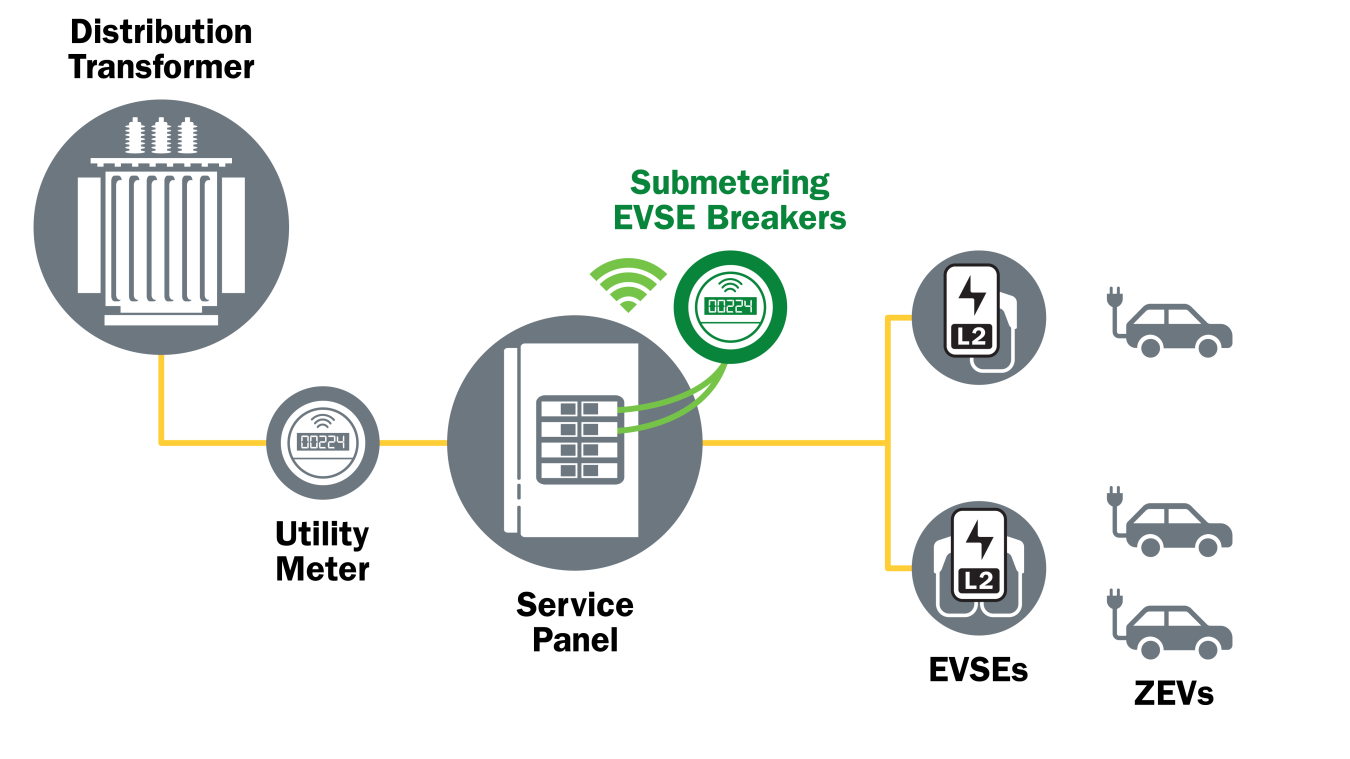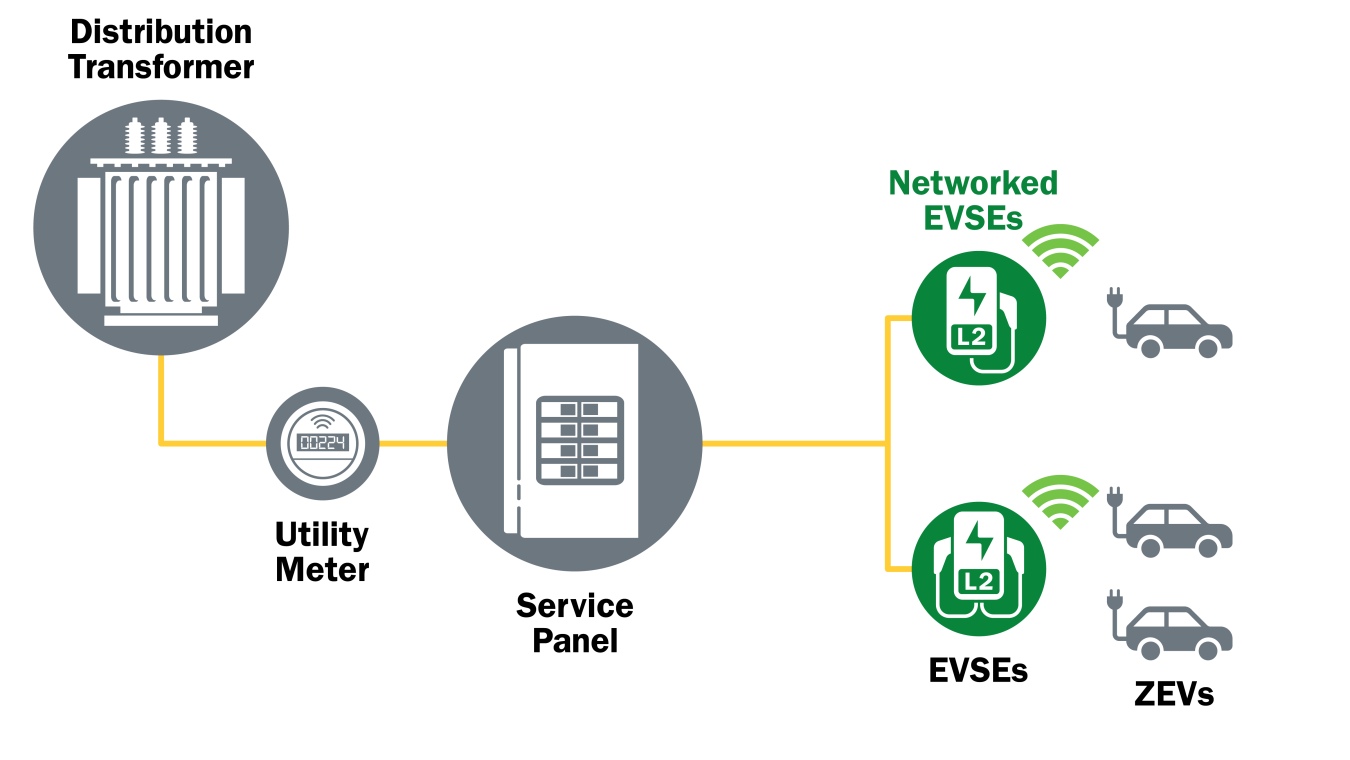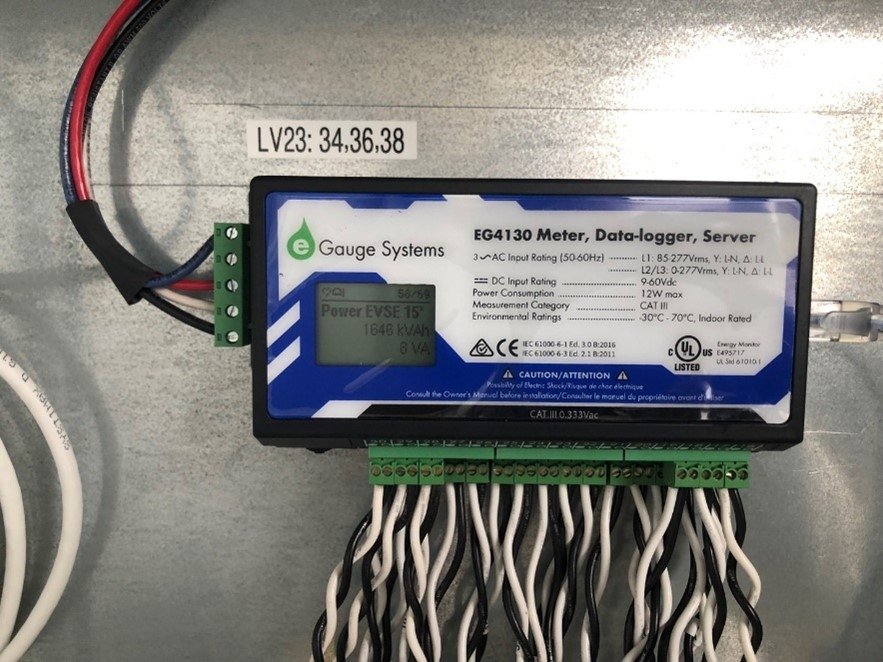For more information on measuring and reporting ZEV charging at the vehicle-level, refer to the Best Practices for Federal Fleet Measurement and Reporting Electricity Use in Electric Vehicles.
Federal agencies are responsible for the accurate measurement and reporting of electricity used to charge zero emission vehicles (ZEVs) from electric vehicle supply equipment (EVSE) installed at federal facilities. The U.S. Department of Energy's Federal Energy Management Program (DOE FEMP) has assembled the following list of best practices for measuring EVSE electricity use at federal buildings and collecting the electricity used to charge both government-owned fleet vehicles and privately owned vehicles (POVs).
Why Facilities Should Measure Electric Vehicle Supply Equipment Units
EVSE, commonly known as electric vehicle (EV) charging stations, supply energy to ZEVs used in federal agencies. Accurate measurement of EVSE electricity use is important for several reasons:
- Energy Independence and Security Act of 2007 benchmarking: The Energy Independence and Security Act requires federal agencies to benchmark building energy performance using systems like ENERGY STAR Portfolio Manager. Installation of EVSE units can affect a building's electricity use, making separate tracking essential to avoid impacting energy performance ratings.
- Reporting requirements: Federal agencies are obligated to report EVSE electricity use as part of their Annual Energy Management Data Report. Additionally, starting in 2023, the Federal Automotive Statistical Tool (FAST) Fueling Center and EVSE Inventory submission also requires federal agencies to report total electricity dispensed by EVSE stations at each EVSE installation for the fiscal year.
Integrating Data for Reporting and Optimization
Compatible networked meters and networked EVSE units can automatically upload data to an Energy Management Information System (EMIS) via communication protocols or APIs. An EMIS facilitates data management, tracking, and optimization of EVSE electricity use. For more information refer to the FEMP EMIS Technical Resource Report.
Differentiating Charging
When reporting EVSE electricity use, it's crucial to distinguish between fleet vehicles and POV. Only fleet vehicle charging electricity use should be reported in the FEMP Annual Energy Management Data Report workbook. Greenhouse gas emissions from POV electricity use is captured separately in the workbook. For EVSE units that are shared between fleet vehicles and POV, metering or submetering alone is not sufficient to track this information.
Options Overview
Table 1 summarizes the available options for measuring EVSE electricity use, along with considerations for each method. Some sites may require a combination of these options to meet reporting requirements effectively.
Table 1 – Options To Measure Electricity From EVSE Units
| Option | Use this method if: | Considerations |
|---|---|---|
|
|
|
|
|
|
|
|
|
|
|
|
Option 1A and 2A: Metering at the Panel (Manual or Networked)

Option 1B and 2B: Submetering at the Panel (Manual or Networked)

Option 3: Cloud Data from Networked EVSE Units

Option 4: Telematics Data from Fleet Vehicles

Reporting Electric Vehicle Supply Equipment Electricity Use
Facility and energy managers should coordinate with site Fleet Managers to ensure consistent reporting across different systems. Reporting methods vary by location and depend on how EVSE electricity use is tracked.
- For guidance on separating EVSE electricity use from other building loads in the ENERGY STAR Portfolio Manager, refer to their FAQ on How To Benchmark EV Charging.
- To report EVSE electricity use in the FEMP Annual Energy Management Data Report, follow these instructions:
- Tab 1.2 Electric Goal
- Fleet vehicle and POV EVSE electricity use should both be removed from the facility electricity use column reported in tab 1.2 Electric Goal. That way the EVSE electricity use does not count against the building intensity calculations.
- Sites can use one of the best practice methods presented above to separate and track EVSE electricity use (e.g., metering, networked EVSEs, telematics) and to remove that electricity use from the building calculations.
- Sites can use one of the best practice methods presented above to separate and track EVSE electricity use (e.g., metering, networked EVSEs, telematics) and to remove that electricity use from the building calculations.
- Fleet vehicle and POV EVSE electricity use should both be removed from the facility electricity use column reported in tab 1.2 Electric Goal. That way the EVSE electricity use does not count against the building intensity calculations.
- Tab 1.3 Electric Excluded
- EVSE electricity usage for fleet vehicles should be reported in tab 1.3 Electric Excluded. POV EVSE electricity use should not be included in this tab.
- Reporting electricity use in this tab requires that sites have a method to separate fleet vehicle and POV EVSE electricity use. If an EVSE is shared between fleet vehicle and POV users, metering alone is not sufficient.
- Reporting electricity use in this tab requires that sites have a method to separate fleet vehicle and POV EVSE electricity use. If an EVSE is shared between fleet vehicle and POV users, metering alone is not sufficient.
- EVSE electricity usage for fleet vehicles should be reported in tab 1.3 Electric Excluded. POV EVSE electricity use should not be included in this tab.
- Tab 2.2 Renewable Energy Data
- For off-grid EVSEs powered by renewable energy sources (such as the Beam EV Arc), the electricity generated and dispensed to a ZEV would be captured in tab 2.2 Renewable Energy Data.
- Tab 1.2 Electric Goal
Starting in 2023, the annual FAST Fueling Center and EVSE Inventory submission includes a field to collect the total electricity dispensed (in kilowatt-hours) by EVSE at each installation but does not differentiate between fleet vehicles and POVs for shared EVSEs.

Case Study: National Renewable Energy Laboratory (NREL)

